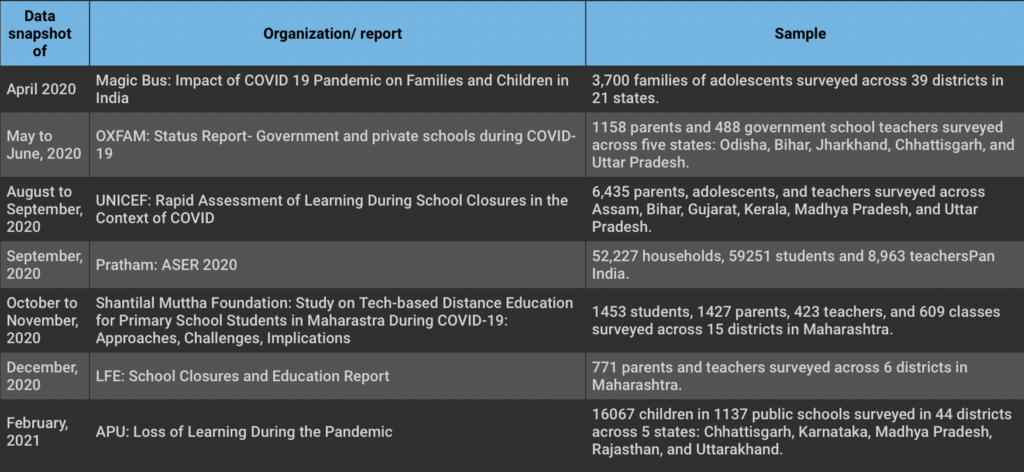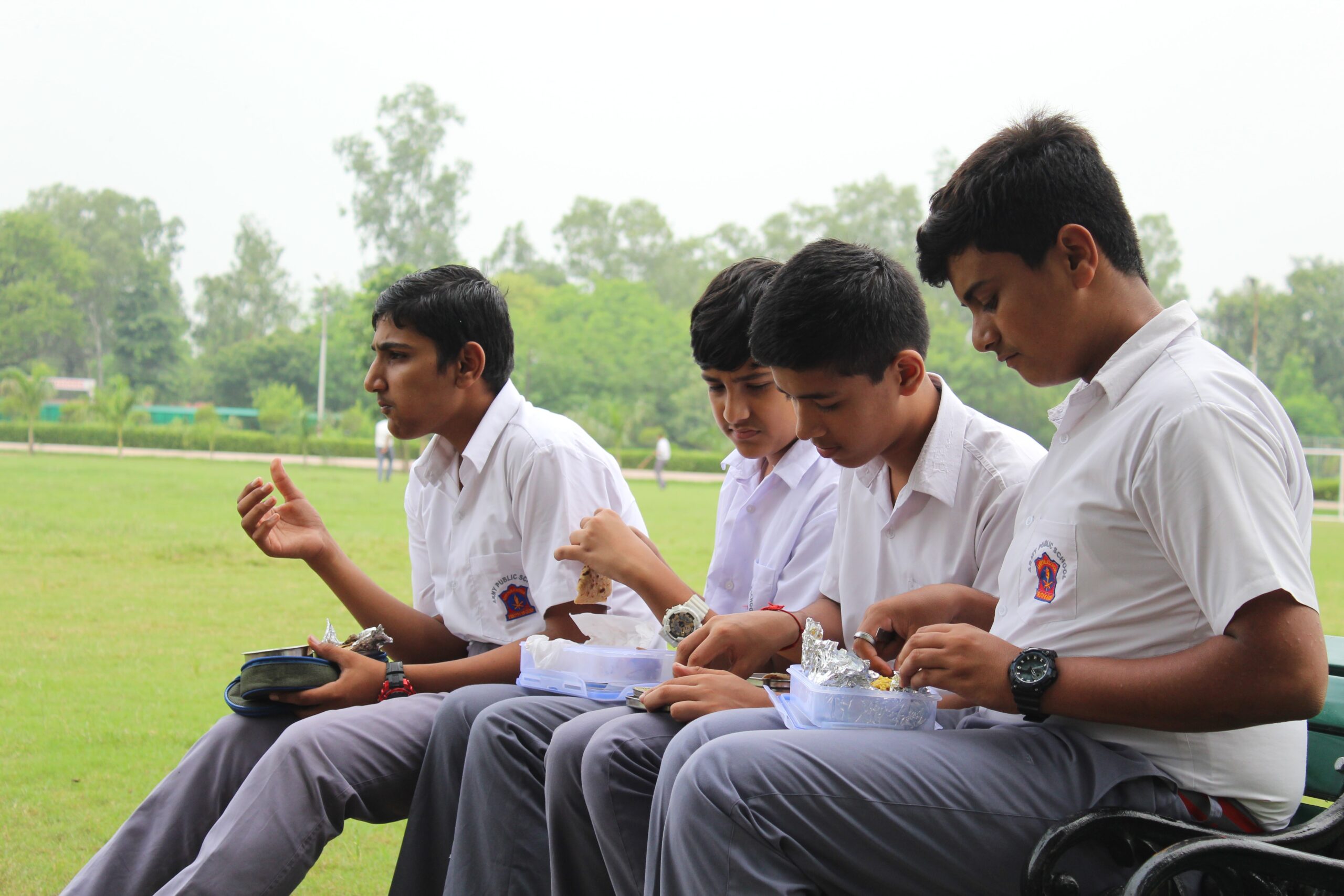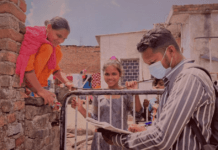March of 2020 marked the beginning of the pandemic in India, speedily leading to lockdowns and school closures. In June of last year, even after the first wave began to recede and economic activities resumed, schools remained closed, and learning moved online for India’s students. Swathes of digital learning initiatives laid bare India’s well-documented digital divide一large proportions of children were unable to adapt to online classes due to a lack of technological devices and supporting infrastructure.
But, a year and a half down the line, how do we make sense of our initial understandings of this flurry of local, district, state, and national level learning initiatives? Where did researchers succeed, and on what grounds did they struggle? Without these answers, evaluating and improving education programs during the pandemic is going to be inefficient一which will only go on to affect student learning in the long run.
There have been many commendable efforts made to understand education during times of COVID-19 with relatively reliable data. Various studies by organisations like Magic Bus, Azim Premji University (APU), Pratham, OXFAM, UNICEF, Leadership for Equity (LFE), and Shantilal Muttha Foundation (SMF), have documented the unfolding of learning models over the past year.
These reports, which include data collected as early as April of 2020, discuss an overlapping set of themes regarding education during COVID-19, and have greatly enhanced our understanding of the existing conditions on the ground.

Earlier reports by OXFAM, Magic Bus and Pratham aimed to comprehend the unfolding impacts of the pandemic on education last year. “We needed to know what education issues were critical on the ground, to reach out to the government about,” says Ankit Vyas, the National Inequality and Education Coordinator at OXFAM India. “At Oxfam India, we looked at the crisis from the lens of how education was being delivered in government and private schools, and also what challenges private school parents might be facing during the pandemic.”
Later reports by SMF, LFE, and APU attempted to understand the impact of the various programs that were rolled out. “Once tech-based distance education was implemented for several months, we wanted to probe whether the entire rollout had achieved certain stability at all,” says Meghana Desai, who heads Programme Monitoring and Evaluation and the Shantilal Muttha Foundation. “We also wanted to gauge the extent of inclusion, so we spoke to 19 children with special needs in our study. We planned our data collection methods in October of last year, and it took us till November to execute them.”
There are several factors constraining the data that was gathered. Each of the studies were undertaken in particular geographical areas and time periods, amid rapidly changing conditions. Each faced specific localised challenges, ranging from discrepancy in data reported by the respondents, to internal family dynamics deciding a student’s access to resources and support.
Yet, in spite of their vastly different geographies, time frames, sample sizes, and challenges the seven reports surveyed here uncovered similar findings一made all the more striking given that each report focuses on different perspectives, geographies, and time durations. 9 trends on the state of education in much of India can be discerned across 7 reports一which may be of critical use to policymakers in the coming year.
What the 9 Trends Say
Trend 1: The availability of and access to educational resources remained one of the biggest areas of concern across the reports. Learning outcomes for students were clearly impacted by their access to Internet-enabled devices. In Leadership For Equity’s Maharashtra-based study, it was found that less than half of the tribal households surveyed possessed any digital device such as smartphones, televisions or computers. In contrast, 91.3% of teachers surveyed reported that they use WhatsApp to interact with their students.
Recommendation 1: Across the board, improving limited access to technology , and its larger implications for equity has been a key point of discussion for policy makers一it is clear that their main focus in the present is to ensure that programs and initiatives reach every single student.
To this end, it is vital to ensure inclusivity by augmenting tech-based interventions with alternative delivery options. These options include printed learning materials or textbooks, or the use of lighter applications that can be downloaded on low-cost smartphones and operated either offline or with 2G internet.
Trend 2: learning losses among students have been unanimously acknowledged as one of the biggest challenges facing the education sector post-lockdown. While the challenge of learning losses have been acknowledged in multiple reports, quantitative data is found only in APU’s report. 92% of the students surveyed have lost at least one specific language ability, while 82% of the students have lost at least one specific mathematical ability from the previous year across all classes.
Recommendation 2: it is not surprising that one of the key recommendations for learning losses is to immediately address it with rapid action plans and remedial teaching. The APU report states that “supplemental support, whether in the form of bridge courses, extended hours, community-based engagements, and teaching-learning materials will be necessary to help children gain lost abilities and to further their learning in the class they return to when schools reopen.” Various specific strategies are also proposed including a 45-day accelerated learning curriculum (focused on foundational skills) that supports a smooth transition for students back to school, assessing learning levels for targeted remedial programs and teaching at the right level.
@Humana_India ‘s Kadam methodology is now being scaled up in Haryana to identify and enrol such out of school children in bridge courses where their learning gaps will be bridged. 2/2https://t.co/EliA8xlkyV
— humana_india (@Humana_India) March 25, 2021
Trend 3: during the past year, initiatives based on information and communications technology (ICT), particularly those requiring internet connections that are reliant on applications like WhatsApp, were hugely popular and have since been examined for their effectiveness. But, many of the reports recommend the need for increasing public awareness of TV- and radio-based programs, particularly given their easy access to marginalized groups. This is because parents and students are both largely unaware of the availability of educational content on TV and radio, which are low-cost sustainable solutions that have so far been underutilized.
Recommendation 3: Many of the issues around access, availability, and quality that students often face while using the internet and smartphones can be mitigated by raising awareness of the educational uses of TV and radio. TV and radio programs can ensure grade-wise repeating schedules, with content variations in different dialects. These can be made available on channels free of cost with wide coverage. This is one area where state governments can initiate publicity campaigns and increase communication efforts on the use of these alternatives.
Trend 4: All seven reports stressed on the long-term integration of technology in teaching and learning, beyond the current crisis. There are many well-documented advantages of using tech tools in learning, which include driving engagement and accommodating multiple learning styles.
Recognising that technology integration is now as essential for schooling as textbooks and uniforms will help accelerate innovation in Indian education, currently stunted due to the limitations of digital infrastructure and weak tech-based pedagogical skills among teachers. For instance, a teacher from Satara district in Maharashtra noted that “there are many problems due to lack of mobile network in our village.” Another from Maharashtra’s Solapur district explains that “ever since COVID-19 struck, [sometimes] there has been work, sometimes there hasn’t been. If there is no work, there is no money for recharging our mobiles, which means our students cannot study.”
Recommendation 4: Technology integration needs to be implemented in a sustainable manner with a comprehensive state-level operational framework to establish a tech-enabled education system. The gap when it comes to digital infrastructure needs to be remedied with dedicated public funds, a convergence of various government departments, or even a collaboration between CSR, philanthropic initiatives, and the government.
Trend 5: A major anticipated consequence of the pandemic is the increase in school drop outs. The ASER 2020 report suggests that due to the closure of schools, the true proportion of “out of school” children cannot be measured. It further reports that the proportion of children not enrolled in school between the age group of 6-10 age groups is more than the children who have indeed dropped out. This is on top of documented evidence of some students whom teachers were still unable to connect with even after half a year of school shutdowns.
Teachers in Pune, Maharashtra, reported that if schools do not start to function normally soon, many parents may opt to marry their girl child. In some instances, economic distress could also force students to drop out of schools entirely. Hence, the closure of schools for a long time could have adverse effects on student enrolments in the long-run.
Recommendation 5: While the quantum of the challenge can only be known when schools reopen, the reports recommend targeted efforts to ensure all children come back to school, particularly children with special needs, students from economically distressed or socially marginalised families, and particularly girl students who are at high risk of being married early. Students from migrant families, or linguistic minority communities, where access and availability of resources can be even more challenging, are also among those considered at risk and should be reached out.
Gender responsive re-enrollment campaigns to prevent students from dropping out will have to be initiated. For those students whom financial challenges may keep away from school, scholarships and cash transfers should be considered.
Trend 6: all the reports recognised the importance of social and emotional well being. There is no denying that students have faced developmental and emotional setbacks due to the pandemic. Concerns for the health and safety of those around them, as well as financial and emotional distress within families. have affected students’ mental health . This could be a threat to their reintegration to schools and it will be important to foster a school culture where students can thrive. As a parent in Latur, Maharashtra, pointed out “providing the same environment is not possible at home. Now, the kids are bored and irritated at home. At school, children play, they study. The school has activities and resources. At home, they do nothing.”
Recommendation 6: decision makers in schools and governments will have to acknowledge the role social and emotional health and wellbeing will have on students’ learning in the short and long term. This can begin with the formulation of a disaster response plan addressing social and emotional health, studies to assess the impact of the pandemic on student mental health, equipping teachers with necessary skills to help students, or even the provision of career counselling.
Bringing lakhs of vulnerable children back to school will be crucial, not just for their continued learning, but to ensure access to basic nutrition and safe space for them, while their parents rebuild their lives!
— Aripana Foundation (@AripanaF) May 16, 2020
Trend 7: teachers have been crucial pillars of learning during the pandemic, delivering programs to students using innovative homegrown methods. However, the studies highlight the need to tackle the challenges that teachers themselves are facing. These range from the safety and health hazards they face in visiting students at their homes, to the allocation of their time to non-teaching duties, to the cost of internet services and devices. A teacher in Nashik, Maharashtra, worries that “if the students get COVID-19, we will be held responsible for making them attend classes. Therefore, schools should open with caution.”
Recommendation 7: Teachers have had to adapt to the use of online resources and the pedagogical aspects of tech integration and for this they need training as well as mentoring support. Any strategy going forward must respond to teachers’ needs to best equip them to support students.
Trend 8: Every study recognised that the involvement of the local community is necessary to ensure students continue learning and come back to school. For instance, the Palak Mitra program implemented in some regions of Maharashtra, used digital and physical content to raise parental awareness on issues related to child wellbeing, remote learning, and experiential learning. Audio recordings, videos, and printed posters on these topics were shared among parent groups.
Recommendation 8: There are a range of recommendations to leverage community participation in the future. Students can be encouraged to learn in community-based mohalla (or street) classes. Parents can be involved in disinfecting schools and opening them up, while families can be actively engaged in ensuring a child’s wellbeing at home. If families cannot provide this support, Panchayat Samitis may be mobilized to identify at-risk and vulnerable children who require extra assistance. The role of parents, communities and local government is thus central to strategy in the medium and long term in mitigating the emotional and learning challenges stemming from school shutdowns.
Trend 9: While the findings in each of these reports focus on students, teachers and parents, the recommendations they make all directly address policy makers. This is because both teachers and parents continuously state that the state governments must take responsibility and make strong, yet sensitive decisions that are effectively communicated in order to enable smooth implementation.
Recommendation 9: state and local governments should play a crucial role in strategising, designing, and implementing future learning programs during the pandemic. This extends not only to the administrative decision makers, but also to state level institutions一like State Councils of Educational Research and Training and District Institutes for Education and Training一in providing adequate support, and the required guidelines on syllabus, assessments, and teacher training, among others.
Featured image courtesy of Dilip Sharma on Unsplash.






